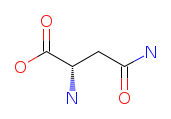Asparagine
Asparagine is known worldwide as the first amino acid that was isolated from its natural source. Back in 1806, Asparagine was isolated from asparagus juice by Pierre Jean Robiquet and Louis-Nicolas Vauquelin.
Chemical structure of Asparagine

Chemical and physical properties of Asparagine
IUPAC Name: (2S)-2,4-Diamino-4-oxobutanoic acid
Symbol: Three-letter code - Asn. One-letter code - N
Molecular Weight: 132.11792 g/mol
Molecular Formula: C4H8N2O3
Canonical SMILES: C(C(C(=O)O)N)C(=O)N
Isomeric SMILES: C([C@@H](C(=O)O)N)C(=O)N
InChIKey Identifier: DCXYFEDJOCDNAF-VYAUFGAVDT
CAS Number: 70-47-3
MDL Number: MFCD00064401
Melting point: 235 °C
RNA codons: AAU, AAC
Solubility in water: 20 g/L (20 °C); pKa - 2,02; pKb - 8,80
Rf value in n-butanol/acetic acid/water = 12:3:5 - 0.50
2D Molfile: Get the molfile
3D PDB file: Get the PDB file
Other names: (S)-2-Aminosuccinic acid 4-amide; alpha-Aminosuccinamic acid; L-Aspartic acid 4-amide; (2S)-2-Amino-3-carbamoyl-propanoic acid
Functions of L-Asparagine in the body
Asparagine is known for its key role in the biosynthesis of glycoproteins. In addition, it is also essential for the synthesis of many other proteins. Human nervous system also needs this amino acid to be able to maintain an equilibrium. Asparagine increases the resistance to fatigue and improves the smooth functioning of the liver. So, Asparagine benefits work best in the field of nervine health and liver protection.
Currently, Asparagine is one of the twenty most common amino acids on our planet - one of the principal and the most abundant elements that help to transport nitrogen. Besides, this amino acid is required by human body cells for the protein production. It can be produced in the liver and is recognized worldwide for its ability to help increase the resistance to fatigue, thus improving athletic stamina.
This amino acid is actually an essential component of proteins involved in signaling, neuronal development and transmission across nerve endings. It is also necessary for transformation of amino acid from one form to another. In addition, Asparagine is known for its key role in the biosynthesis of glycoproteins, as well as in the synthesis of many other proteins.
People experiencing a deficiency of Asparagine may suffer from poor metabolism and show inability to manufacture and excrete urea, which is waste product of excess dietary protein. Such people thus may reveal symptoms like depression, confusion, and headaches. In addition, among the main benefits of Asparagine you can find the facts that it may help in metabolizing ammonia in the human body and enable proper functioning of the liver, as well as it enables a robust system resistant to fatigue.
Food sources of Asparagine
The most common typical dietary sources of this amino acid include beef, chicken, dairy products, seafood, and eggs. As for vegetarians, they may find helpful to consume asparagus, soy, and whole grains to get more amino acid from them.
Asparagus. As the name suggests, asparagus is a particularly rich source of asparagine. It is also a nutritious vegetable that provides various vitamins and minerals.
Legumes. Beans, lentils, and peas contain asparagine. These are good plant-based sources of protein and fiber.
Nuts and Seeds. Almonds, peanuts, and sesame seeds are examples of nuts and seeds that contain asparagine. They are also rich in healthy fats and other nutrients.
Whole Grains. Foods like wheat, oats, and rice contain asparagine. Whole grains are important sources of carbohydrates, fiber, and various vitamins and minerals.
Potatoes. Potatoes, particularly when they are baked or boiled, contain asparagine. Sweet potatoes, a related tuber, also contain this amino acid.
Dairy Products. Milk and other dairy products contain asparagine. These foods are good sources of calcium and protein.
Poultry and Meat. Chicken, turkey, and beef contain asparagine. These meats are rich in protein and essential nutrients like iron and zinc.
Seafood. Fish such as salmon and tuna contain asparagine. They are also excellent sources of omega-3 fatty acids.
Since the body can produce asparagine on its own, there is typically no specific dietary recommendation for this amino acid. A well-balanced diet that includes a variety of foods from different food groups can provide all the amino acids, including asparagine, that the body needs for normal functioning.